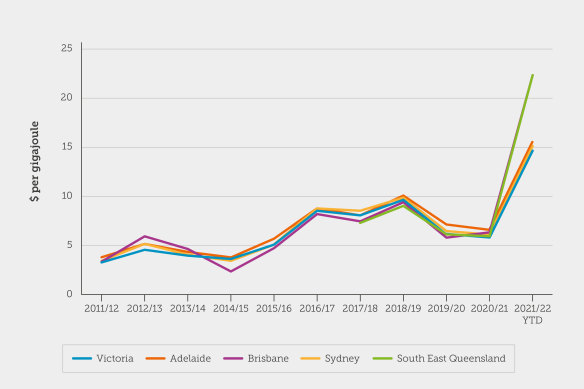
How much could you save?
Households that switch to fully electric in Hobart can save up to $1899 on their annual bills, in Canberra up to $1876, in Adelaide $1457, Brisbane $1424, Melbourne $1207, Sydney $924 and Perth $803.
The biggest bill savings were found to be in Brisbane, where gas is significantly more expensive than other capital cities, and in Hobart and Canberra because of their colder climates, Climate Council researchers found.
Being connected to the gas network, even if you do not use gas, can cost hundreds of dollars a year in daily supply charges, with the most expensive annual bill being $280 for Melbourne residents, the report says.
The wholesale price of gas has almost tripled since last year, with 80 per cent of supplies shipped overseas, and Australian prices tied to a volatile international market.

Gas market prices in Victoria, Adelaide, Brisbane, Sydney and South East Queensland, 2011/12 to 2021/22. (Source: Australian Energy Regulator, 2022.) Credit:Climate Council, Switch and Save report
Australian households meet their energy needs through a combination of different fuel sources, and piped gas accounts for almost 40 per cent.
In Victoria and the ACT more than half of all energy used in homes comes from piped gas, while in Tasmania and Queensland, the use of residential gas is very low.
How it was calculated
The total bill savings were calculated by combining heating, cooking and hot water bills per year for an example household using gas appliances (including daily connection fees) and comparing these with the combined bills for a household with electric appliances at the same level of use.
Saul Griffith, the author of The Big Switch and the head of Rewiring Australia, said his organisation carried out a study last year that considered the full electrification of Australian houses, including vehicles.
It found that by 2030, the average householder should be saving between $3000 and $5000 a year.
“If we redid the analysis now, those numbers would be higher,” Griffiths said. “Of course, you have to power that with renewable electricity, but that is now cheaper than coal.”
What about the cost?
There are, of course, costs associated with switching from gas appliances. Some purchases, such as rooftop solar and electric appliances, should be viewed as an investment because they could make such significant savings that the upfront cost was effectively “paid back” over time, the researchers said.
Loading
They calculated two payback scenarios: the first based on someone buying lower-priced electric appliances, at a cost of $7800; and the second based on higher-priced appliances, at $14,900. Both scenarios included $3000 for installation costs.
In Melbourne, this would take eight and 12 years respectively, while in Sydney it would take 13 and 16 years.
Once Jolley and her family installed the electric heat pump, they decided to turn off their ducted gas heating and rely on electric panel heaters, and later, an induction cooktop.
Jolley has calculated that her family saves about $100 a month in energy costs, despite now having another child and she and her partner now working at home. Their transition was helped with a low-interest loan through the Victorian government’s Solar Homes scheme.
As well as taking these steps at home, Jolley has hosted climate information sessions, talked to her local member of parliament about her concerns and joined environmental campaigns.
“There are many ways we can engage with to try and soften the blows of climate change,” she said.
Get to the heart of what’s happening with climate change and the environment. Our fortnightly Environment newsletter brings you the news, the issues and the solutions. Sign up here.









 Add Category
Add Category